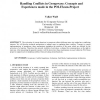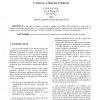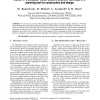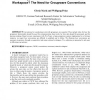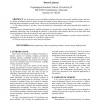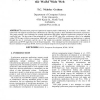126
Voted
INTERACT
1997
15 years 2 months ago
1997
The activation of certain functions in groupware affects different users who might have conflicting interests. We will develop technical mechanisms to support users in regulating t...
116
click to vote
INTERACT
1997
15 years 2 months ago
1997
In the following we will describe experiences made when introducing a shared workspace in a German federal ministry to support the cooperative typing of documents. It will be shown...
117
Voted
INTERACT
1997
15 years 2 months ago
1997
It is time to go beyond the established approaches in human-computer interaction. With the Augmented Reality (AR) design strategy humans are able to behave as much as possible in a...
119
click to vote
INTERACT
1997
15 years 2 months ago
1997
Conventions for conducting work with groupware are essential. They include rules for how the groupware functionality should be used for communication about work, for how data shoul...
109
click to vote
INTERACT
1997
15 years 2 months ago
1997
This paper describes an innovative approach to teaching about human-computer interaction to a large class of students in their third year of a Computer Science major. Because of t...
104
Voted
INTERACT
1997
15 years 2 months ago
1997
ABSTRACT Do developers use proven usability techniques like user involvement, usability testing, and iterative design in industrial practice? Based on inside knowledge of many diff...
98
Voted
INTERACT
1997
15 years 2 months ago
1997
ABSTRACT This paper builds on an existing model of human-computer interaction that focuses on the information structures employed as distributed information resources by users in d...
107
Voted
INTERACT
1997
15 years 2 months ago
1997
In order for global software to be marketed successfully, the design of interfaces should accommodate users’ cultural differences. This study examines users’ culturally specifi...
107
click to vote
INTERACT
1997
15 years 2 months ago
1997
Synchronous groupware applications support people collaborating in real time over a distance. The world wide web supports asynchronous collaboration by allowing people to share dis...
